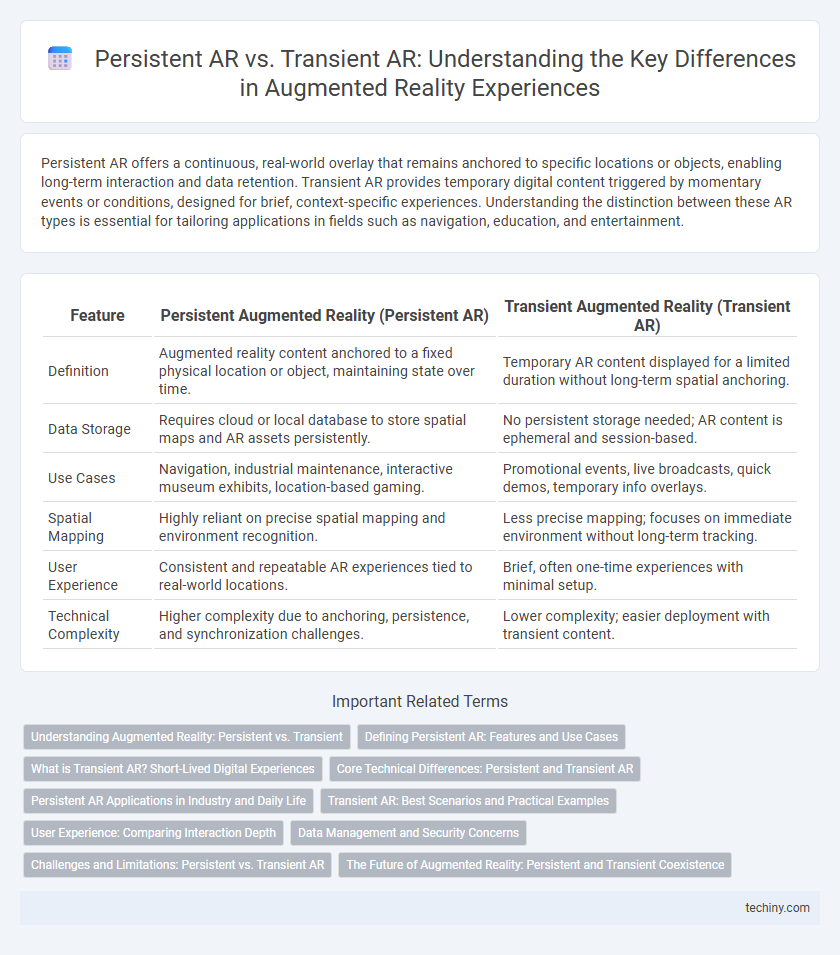Persistent AR offers a continuous, real-world overlay that remains anchored to specific locations or objects, enabling long-term interaction and data retention. Transient AR provides temporary digital content triggered by momentary events or conditions, designed for brief, context-specific experiences. Understanding the distinction between these AR types is essential for tailoring applications in fields such as navigation, education, and entertainment.
Table of Comparison
| Feature | Persistent Augmented Reality (Persistent AR) | Transient Augmented Reality (Transient AR) |
|---|---|---|
| Definition | Augmented reality content anchored to a fixed physical location or object, maintaining state over time. | Temporary AR content displayed for a limited duration without long-term spatial anchoring. |
| Data Storage | Requires cloud or local database to store spatial maps and AR assets persistently. | No persistent storage needed; AR content is ephemeral and session-based. |
| Use Cases | Navigation, industrial maintenance, interactive museum exhibits, location-based gaming. | Promotional events, live broadcasts, quick demos, temporary info overlays. |
| Spatial Mapping | Highly reliant on precise spatial mapping and environment recognition. | Less precise mapping; focuses on immediate environment without long-term tracking. |
| User Experience | Consistent and repeatable AR experiences tied to real-world locations. | Brief, often one-time experiences with minimal setup. |
| Technical Complexity | Higher complexity due to anchoring, persistence, and synchronization challenges. | Lower complexity; easier deployment with transient content. |
Understanding Augmented Reality: Persistent vs. Transient
Persistent AR maintains digital overlays anchored to specific physical locations, enabling continuous interaction and real-world context retention over time. Transient AR provides temporary, momentary augmentations that disappear once the session ends or device moves away, often used for quick, interactive experiences. Differentiating between persistent and transient AR is crucial for developers to optimize user engagement and application functionality based on context stability and duration requirements.
Defining Persistent AR: Features and Use Cases
Persistent AR creates digital content anchored to specific real-world locations, maintaining spatial alignment across multiple sessions and users. Key features include continuous environmental mapping, multi-user synchronization, and real-time updates, enabling collaborative applications in industries like architecture, retail, and education. Use cases range from interactive museum exhibits and urban navigation aids to long-term asset visualization in industrial maintenance.
What is Transient AR? Short-Lived Digital Experiences
Transient AR refers to augmented reality experiences that are temporary and exist only for a short duration, often tied to specific events or locations. These short-lived digital overlays vanish once the user moves away or the event ends, offering momentary interaction without lasting impact. Examples include AR filters during live events or promotional campaigns designed for immediate engagement but no long-term presence.
Core Technical Differences: Persistent and Transient AR
Persistent AR maintains digital content anchored to specific real-world locations or objects over extended periods, utilizing advanced SLAM (Simultaneous Localization and Mapping) and cloud anchor technologies to ensure spatial consistency and user collaboration. Transient AR delivers temporary, context-specific overlays that disappear once the session ends, relying primarily on device sensors and immediate environment mapping without long-term data storage. The core technical difference lies in Persistent AR's use of persistent spatial mapping and cloud synchronization versus Transient AR's emphasis on ephemeral tracking and real-time rendering.
Persistent AR Applications in Industry and Daily Life
Persistent AR maintains spatial anchors over time, enabling continuous interaction with virtual objects in real-world environments. In industry, Persistent AR enhances equipment maintenance, assembly processes, and training by overlaying interactive 3D models that remain aligned with physical components. Daily life applications include smart navigation in urban spaces, continuous home design visualization, and immersive retail experiences with virtual try-ons that persist across sessions.
Transient AR: Best Scenarios and Practical Examples
Transient AR excels in short-term, location-specific applications such as retail promotions, live events, and interactive gaming, where real-time engagement drives user experience. Practical examples include AR filters on social media platforms, interactive museum exhibits, and pop-up virtual try-ons in stores, providing immediate, context-sensitive information without the need for long-term tracking. These scenarios leverage Transient AR's ability to deliver dynamic, disposable content tailored to momentary interactions.
User Experience: Comparing Interaction Depth
Persistent AR delivers a more immersive user experience by maintaining digital content consistently anchored to real-world environments, allowing for deeper interaction and continuity over time. Transient AR provides brief, context-specific interactions with virtual elements that appear temporarily, limiting user engagement depth but enhancing ease of access and spontaneity. Evaluating user experience in AR applications depends on balancing the need for prolonged interaction (Persistent AR) against flexibility and momentary engagement (Transient AR).
Data Management and Security Concerns
Persistent AR requires robust data management systems to continuously store, update, and synchronize large volumes of spatial data across multiple sessions and devices, enhancing long-term user interactions. Security concerns in Persistent AR focus on protecting sensitive location-based data and preventing unauthorized access or manipulation of persistent virtual objects. Transient AR, being session-based and temporary, involves less complex data storage but still demands encryption and secure transmission to safeguard real-time user data and prevent potential breaches during active interactions.
Challenges and Limitations: Persistent vs. Transient AR
Persistent AR faces challenges with maintaining consistent digital content alignment over time and across varying environmental conditions, demanding robust spatial mapping and data storage solutions. Transient AR struggles with limited interaction timeframes and frequently resetting experiences, which can hinder immersive user engagement and data continuity. Both types encounter limitations in hardware capabilities, including sensor accuracy and processing power, impacting overall user experience quality.
The Future of Augmented Reality: Persistent and Transient Coexistence
Persistent AR anchors digital content in real-world environments for continuous interaction, enhancing navigation, industrial maintenance, and urban planning with lasting data integration. Transient AR offers temporary, context-specific overlays ideal for dynamic marketing, gaming, or real-time information updates that vanish after use. The future of augmented reality hinges on the seamless coexistence of persistent and transient AR, driving versatile applications by combining stable, long-term augmentation with flexible, momentary experiences.
Persistent AR vs Transient AR Infographic

 techiny.com
techiny.com